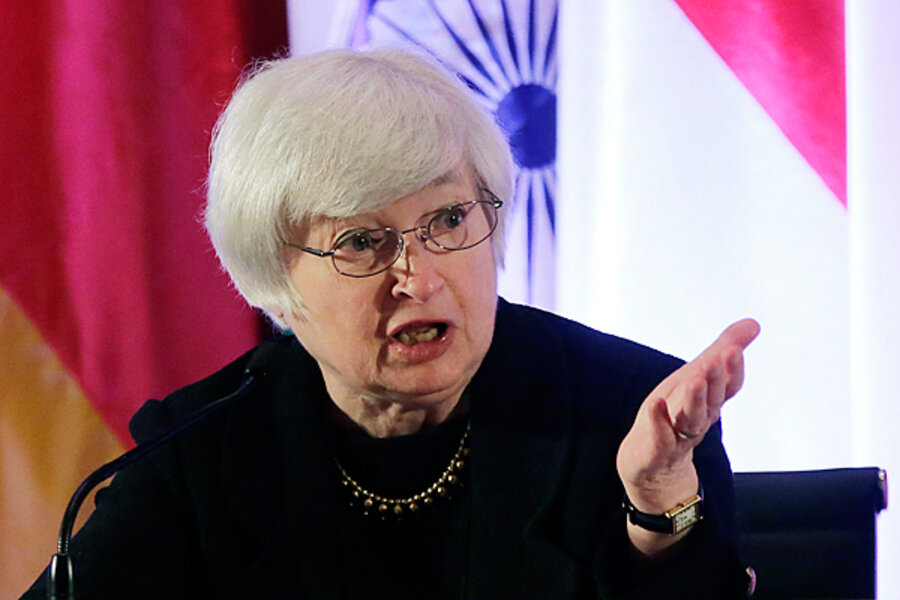Janet Yellen as Fed chairman: What stamp would she put on 'taper' question?
Loading...
| Washington
President Obama’s nomination of Janet Yellen to be the next Federal Reserve chairman is being greeted as a reassuring step – a signal of continuity and competence at the helm of America’s central bank during difficult times.
Ms. Yellen is a longtime Fed policymaker, and she has been an ally of current Chairman Ben Bernanke on key decisions designed to promote growth in a weak economy.
But the nomination also amplifies questions about when and how the Fed will taper or pare back its massive efforts to stimulate economic growth in the wake of an unusually deep recession. Tightening policy too soon could hurt a fragile world economy, but waiting too long could raise the risk of inflation – and the risk of a Fed poorly positioned to deal with that inflationary pressure.
Mr. Obama’s choice of Yellen follows several months of public vetting of prospective job candidates. The other main name considered was the more controversial Larry Summers, a former economic official in both the Obama and Clinton presidencies.
Yellen, unlike Summers, has spent a large chunk of her career at the Fed. And on the so-called taper question, she appears closely aligned with Mr. Bernanke’s caution about removing quantitative easing (a Fed bond-buying program) when there may be doubts about the economy’s forward momentum.
Investors generally welcomed the choice of Yellen, with its implied continuity in Fed direction. Stock prices and the US dollar rose modestly as Wednesday trading opened, despite a storm in Congress over the budget and national debt limit.
Yet the Yellen nomination, to be formally announced Wednesday afternoon, also signals the dawn of a new era at the Fed, ripe with the prospect of policy changes that could have important effects on the economy in the United States and worldwide.
That’s partly just the nature of job turnover. Each Fed chairman puts his or her own stamp on the course of policy, regardless of whether the individual has served in the shadow of another Fed chief. Remember, Bernanke was a Fed governor under Alan Greenspan, and then he ended up taking policy in significant new directions. Speaking of “his or her,” it’s worth noting that Yellen, if confirmed by the US Senate, will be the first woman to lead America’s central bank.
Bernanke’s second four-year term ends on Jan 31. That’s when Yellen, the Fed’s current vice chair, would start in the top job.
A new policy era may also be on the horizon for a reason that goes beyond the simple change of faces: economic conditions. Many forecasters see the pace of recovery improving in coming months, to a roughly 2.6 percent annual growth rate.
That wouldn’t be a race-ahead rate, but it comes as the labor market has been gradually healing. Increasingly, Fed policymakers including Bernanke have talked about the goal of normalizing monetary policy – starting by scaling back the central bank’s extraordinary bond-buying program.
Many economists credit this quantitative easing program with helping to keep long-term interest rates low, thus aiding the recovery. But it also adds to a gargantuan Fed balance sheet of Treasury and mortgage bonds, raising the question of what the Fed’s “exit strategy” is.
Here’s one way to think about the risk: When the Fed buys bonds, the payment for those bonds ends up as “excess reserves” in the vaults of private-sector banks, economist Gary Shilling explains. For now, because economic growth is tepid, this isn’t producing any overheating in the world of bank lending.
But “[when] the economy resumes faster growth, excess reserves could propel the economy through full employment and into serious inflation,” Mr. Shilling warns in a new written commentary.
That may not happen for a few years, he adds. But the risk is still one for the Fed to ponder, because that giant balance sheet of bonds can’t be adjusted in a hurry.
“If assets are sold off rapidly, interest rates could well leap, precipitating a recession,” Shilling says.
Bernanke has voiced confidence that the Fed can successfully navigate the transition away from quantitative easing and ultra-low interest rates.
But starting in May this year, growing talk from Fed officials about merely reducing the $85-billion-per-month pace of bond purchases by the Fed – not downsizing the Fed’s overall balance sheet – was enough to fuel a spike in interest rates in the US and other nations.
Bond markets listened to the talk and heard signals that an era of all-out monetary stimulus was at least starting to end. This pushed up mortgage rates for US borrowers. And when bond-market conditions tighten in the US, the effects ripple overseas, especially to emerging-market nations such as India and Brazil.
Forecasters have dialed back their outlook for growth in emerging economies.
The Fed’s policymaking committee surprised many investors by deciding at its September meeting not to taper the bond purchases just yet. Now many Fed-watchers expect that to happen in December.
Fed officials including Yellen have signaled that they want to see solid improvement in the job market before taking steps that remove monetary stimulus.
But although Yellen is viewed as “dovish,” in contrast with the inflation “hawks” on the policy committee, that doesn’t mean she isn’t mindful of the need for careful balancing of the policy risks ahead.
Her four-year term could call for plenty of those balancing skills.






